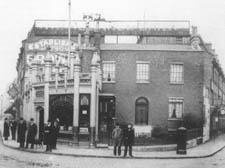|
|
 |
| |
Stories from the streets
where you live
Two new books reveal a hidden history of the borough’s people and places, writes Dan Carrier
The Camden Town Book.
By John Richardson. Historical Publications £14.50
The Streets of Highgate.
By the Camden History Society £7.50
THE figure of Britannia stares down forlornly at the four lanes of one-way traffic heading north along Camden High Street.
Her smog-scarred face says it all: it does not seem to be a nice position for the Roman goddess who became the female personification of Caesar’s northern conquest. But her presence has given the intersection of Camden Road, Camden High Street, Parkway and Kentish Town Road its name – Britannia Junction, and now a new book revealing an A to Z of the history of Camden Town explains why. She was placed on her lofty perch to mark the place of the Britannia Hotel, which, according to licensing records, dates from 1777.
The Camden Town Book by historian John Richardson is one of two new local history books published this autumn.
It tells some interesting tales, and will remind people of how much the area has changed.
The first entry is the ABC Bakery – the former red and white brick building now occupied by Sainsbury’s. The picture shows a handsome building which will be fondly remembered by some, and could go so far to conjure up a waft of baking around the nostrils.
The book remembers how the ABC company was not just well-known for aerated bread, but also for a chain of tea houses. John Richardson points out there were double the number of ABC dining houses in London than the better-known Lyons Corner Houses.
Another aspect of the book will make you shudder to think of how change is not always for the best. There are many buildings, companies and groups that have disappeared which sound like a good idea today. Under a heading Baths and Washhouses, we are informed of ornate Turkish baths which opened in Kentish Town Road in 1878.
Other places of leisure are missed: Mr Richardson has managed to source some great photos and the Bedford Tavern and Music Hall looks a wonderful venue. It was found at 80 Arlington Road and had a pleasure garden serving tea. The theatre played host to Charlie Chaplin and for a brief time was used as a cinema.
Brown’s dairy could be found on what is now the site of the HSBC bank on the corner of Camden High Street and Kentish Town Road, by the Tube station. It was more than just a dairy – cows were kept in fields behind the shop, where the Buck Street market stands.
When reading this excellent history, you can’t help but feel a sense of loss at the disappearance of such corners of our past.
The Streets of Highgate marks the 13th and final piece of a project that has taken 37 years to complete.
The members of the Camden History Society have now researched the history of every street and district in Camden, an undertaking unique in the capital and possibly in the country.
They are a cross between Sir Nikolaus Pevsner’s architectural guides and walking books. Neatly slicing Highgate into sections, the book suggests circular routes so you can take a stroll and discover the stories behind the front doors.
What is apparent is that Highgate is full of quirky trivia: as the book states: “this hill town was also a frontier town, and for may centuries a staging post of English history...”
Route 1 starts in Highgate Village: the section reveals that the Gatehouse is the oldest recorded structure in the village, dating from the 14th century – think about that next time you are supping a pint there. The book states: “given its antiquity and importance for passing trade, the Gatehouse became a popular location for the strange Highgate custom of ‘Swearing on the Horns’.”
Dating from the 17th century, the horns were the Foresters badge of office and is related to a fraternity of drovers who would move their beasts through the streets of the area on their way to markets in London. They had to repeat a nonsensical oath, swearing their allegiance to merriment.
Further towards the Heath we are told that Fitzroy Park was home in 1842 to Thomas Lea, a wealthy coal merchant. Lea would drive to London with two loaded pistols, which he would leave behind the bar at the Duke of St Albans pub each morning, and then collect on his way back, because he feared he would be robbed in the wilds of Highgate West Hill. Highgate still had the reputation for highway robberies.
And the people behind the doors are remembered: we learn that in Bisham Gardens, a sea captain, Peter Heywood, retired in 1818. We can only hope it provided him with some well-earned rest: as a 16-year-old, he had been a midshipman on HMS Bounty and got left behind when Captain Bligh was set adrift. When he managed to get back home, he was tried for mutiny. Despite the experience, he was not discouraged. He rose to the rank of captain and became a distinguished hydrographic surveyor.
More contemporary historical facts abound: another distinguished resident of the street was Margot Jeffreys (1916 to 1999), who was the first professor of medical sociology at the University of London. Her family still live in Swains Lane.
Highgate Newtown is covered, and pictures of how it looked before the rebuilding of the 1970s will bring back memories.
The Kinks’ album Muswell Hillbillies featured a picture of the group posing on the corner of Lulot Street and Retcar Street: behind them is a shop front boasting the legend “Cats On Holiday”. The name of the cattery became a well-known moniker in the US when an American rock band adopted it in honour of their favourite pop group.

|
 |
|
 |
 |
|
 |
|



